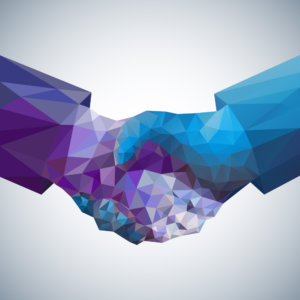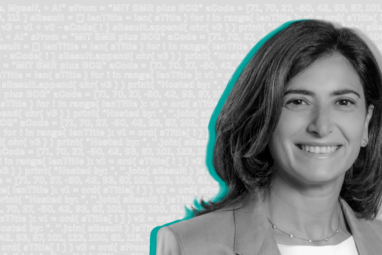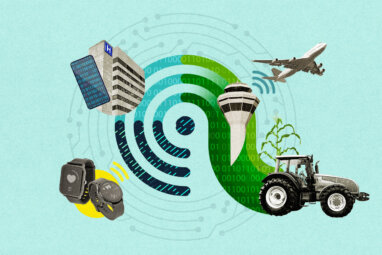Leveraging the Extended Enterprise: MITRE’s Handshake Tool Builds Virtual Collaboration
“The notion that we were going to crowdsource certain functions really was unheard of,” says Donna Cuomo, an associate director of the MITRE Corporation, a $1.4 billion nonprofit R&D organization. But a social business tool MITRE developed called Handshake is helping make that happen.
Topics
Social Business
The nonprofit MITRE Corporation has a unique role in research and development: The $1.4 billion organization operates federally funded research and development centers. Founded by the U.S. Congress in 1958 to expand military-related work being done in the computer laboratories of the Massachusetts Institute of Technology, MITRE’s centers today are sponsored by some of the biggest U.S. agencies — including the Department of Defense, the Department of Homeland Security and the Centers for Medicare & Medicaid Services.
MITRE’s R&D centers assist the United States government with scientific research and analysis, development and acquisition, and systems engineering and integration. Nurturing knowledge exchange both within each research center’s community and among the centers as a group is a chief component of MITRE’s mission.
MITRE’s website makes the organization’s role in all this clear: “Congress chartered MITRE to work in the public interest. We have no commercial interests. We have no owners or shareholders, and we can’t compete for anything except the right to operate [our centers] … organizations are able and willing to share data because they know we won’t use it for a competitive advantage.”
One of MITRE’s tools for helping organizations share data is a social networking tool it developed called Handshake. There’s a high bar for Handshake: It has to break down technological barriers and make it easy for players from different organizations to collaborate virtually, all while protecting sensitive information. Since debuting in 2009, thousands of people both inside of MITRE and outside at federal, state and local agencies have used the tool in some capacity. For many people, Handshake has become second hand.
In a conversation with Gerald C. (Jerry) Kane, an associate professor of information systems at the Carroll School of Management at Boston College and guest editor for MIT Sloan Management Review’s Social Business Big Idea Initiative, MITRE executives Donna Cuomo, Laurie Damianos and Stan Drozdetski explain how Handshake has influenced business at MITRE and what challenges they’ve faced in its implementation.
Can we start with an overview of each of your roles at MITRE?
Donna Cuomo: Sure. I’m currently the associate director for Knowledge, Information and Collaboration Solutions, which is a division within our IT organization. I led a research innovation area, which was overseeing some research activities in social media, including Handshake. I’ve been with the company 25 years.
Laurie Damianos: I am the associate department head of Collaboration and Social Computing. I’ve been at MITRE for 17 years. My title is principal artificial intelligence engineer. I am in a different center, but over the past eight years I’ve had the opportunity to work with Donna and Stan in the corporate work, including on Handshake.
Stan Drozdetski: And I’ve been at MITRE for about nine years working as a user experience designer in our corporate IT. Recently I stepped into the product ownership role and Handshake basically became my responsibility. I will also say that as MITRE takes on a wider approach and looks at social networking as just one of the means that we engage with our sponsors, we are trying to enhance partner engagement, and I provide collaboration support for some of those broader partner engagement functions.
So tell us about Handshake, which is a social networking tool MITRE developed. I know that it includes user profiles, discussion capabilities, messaging and wikis, and I know that it’s been used to facilitate conversations both internally and among external partners. How has that project gone and what are the opportunities and challenges it has presented over the years?
Cuomo: Going back before Handshake, I believe MITRE was actually one of the first users of Internet technology inside the corporation. We’ve always used it for knowledge management and people connection and to help people find experts and people doing similar work across our distributed enterprise.
We had Microsoft SharePoint and we had LISTSERVs and we had different collaboration capabilities already when the social networking phenomenon hit.
But when talking about how we could leverage social media even more, we got some guidance from our upper management that said if we’re going to do another collaboration tool like a social business networking platform, let’s deploy it in a way that we can use it to better engage with our sponsors, our customers, our partners — people outside of MITRE — because we didn’t have as much capability in that area. MITRE likes to think of itself as a broker in terms of getting the right expertise from around the country onto our sponsor’s problems.
The point was to help our staff leverage the extended enterprise, which is the phrase we like to use. With that, I’ll turn it over to Stan and Laurie to talk about some of their use cases and success stories.
Great. Stan, how has Handshake been utilized?
Drozdetski: The first interesting example is that almost as soon as we deployed the social networking platform, which allowed people to easily form groups — and that was key, we made it as easy as possible, and anybody could create a group — one of the first customers was actually our internal IT department. User engagement across the company is always a challenge, and application development groups quickly started realizing that putting discussions out around new application capabilities, being transparent, enabled not just the easy crowdsourcing of user ideas, but actual consensus building. People came together and thought about each other’s contributions and, as a result, created something that not one person, and especially not one IT application owner, could come up with on their own.
So the first applications were internal.
Drozdetski: Yes. Now, the original intention was not just to support internal collaboration but also collaboration across organizations.
An example of how it has been used externally is that MITRE sometimes has to rehab or build a new building or site. That process involves contractors, architects and facilities folks who have to collaborate. And they found that Handshake was a pretty useful place to have that collaboration because you could establish this ongoing discussion, complete with files, photos, documents and so on. All that would live in one place. It helped with status tracking, and it cut down on communication challenges there.
Another good example was a very successful multi-organizational group that was trying to connect people doing cost estimations — literally trying to cost out how much various types of large agency projects would cost. They had a common goal of sharing that information because looking at multiple cases of system deployment over and over gave all of them an extra data point to use in their own estimations.
They created a community and people could come in and ask questions such as, “we’re trying to deploy 1,000 desktops and configure and ship them to a certain site. How much would that cost?” And somebody in that large community might say, “Oh, I’ve worked on that kind of a case or I know of a published example of where they’ve done that estimation.” So this invited crowd was crowdsourcing information across organizational boundaries.
Cuomo: That group was called the Cost Facts Group. They had over 135 stakeholders, and there were 14 or more different government agencies represented in that group, as well as some contractors and academia. Another early example of an external community formed across organizational boundaries was a Homeland Security-related group that brought together first responders from the federal, state, and local level, along with the private sector to discuss common issues and share information.
So these communities get set up and MITRE’s sort of the information broker, or at least MITRE sets up the environment so the information can get brokered. Does MITRE benefit from being in that position?
Cuomo: I think MITRE benefits in that we are often supporting many of these agencies directly and this enhances that support, and our customers benefit. For instance, there was a case where one organization was able to get a detailed answer from another sponsor within 48 hours about the cost of outfitting a test and evaluation facility. MITRE helped the aviation community share safety information in a trusted environment. I think our customers look at us favorably in that we’re doing this brokering, that we’re identifying people with common issues and problems and then helping them solve each other’s problems, because they have the data in some cases and we do not.
Drozdetski: MITRE is unique, in some ways, in being able to serve in this type of role because we are not-for-profit.
What challenges have you run into since Handshake was introduced that you might have not thought of or foreseen when you first launched it?
Damianos: Well, one issue we hit almost immediately was what level of information sensitivity could be hosted in Handshake. A lot of topics our users would like to talk about are in the sensitive area, so we had to provide guidance. Right now, Handshake is only approved for sharing non-sensitive information, and we are having people use other systems, which aren’t as social, for sharing information with higher sensitivity. We will continue to revisit this, as we address in more depth our trust framework for content.
Another challenge is the identity problem. Initially, corporate IT was running the Handshake platform, a SharePoint program, and a “large file” transfer system for sharing large files, and they each had their own account system for partners. So if our partners were to use all three of those systems, they would have had three different accounts, three different passwords. We have since moved to a common identity capability, so partners have a single MITRE account. We are also exploring accepting the trusted identity credentials of our partners. We are doing this by working on something called a Dynamic Identity Trust Framework where we will decide which credentials we’ll trust, to what level, under what circumstances.
Donna, was there another challenge you wanted to mention?
Cuomo: After Handshake launched, some people complained about information overload. If you were a member of many different groups and had subscribed to those groups, you were constantly getting email updates or you could choose to get a single digest. But one of the challenges was that some people wanted the real-time notifications of activity from some of the project groups, but wanted a daily digest version of activities from other groups.
We were able to design a system that allowed people to fine-tune the types of notifications they received and in what form. We also added the ability to comment on discussion posts directly from the email message and also to turn off notifications on particular threads that they no longer wanted to be involved in. This fine-tuning was important to our users.
How deeply has Handshake permeated MITRE internally? You said that staff already had other collaboration tools that must have been working to some extent.
Damianos: Well, let me talk about adoption. We have been doing a longitudinal evaluation to understand over time how people use such a capability. MITRE employees can all self-join, and so our user base grew pretty rapidly. At this point we have probably 100% adoption among staff who are likely to need a capability like this.
At the beginning, in 2009 and 2010, you’d hear things in conversations in the hallways like, “Oh, I put it on Handshake” or “Have you heard about Handshake?” Some people found it really useful and moved a lot of their project work onto it quickly and started creating these different groups on Handshake. Handshake’s activity river, which we also have as a personalized element on our corporate homepage, provides superior situational awareness of new activity in groups or among your connections that other capabilities have a hard time matching.
Others users had a harder time sort of adjusting to that type of tool. There were people who prefer to work with some of the existing technology. They’re accustomed to using SharePoint so they still do, but a lot of people have also combined the tools. They’ll use Handshake for collaboration and project discussion to work on ideas but keep their deliverables and materials in SharePoint, where they can be more secure and they have a more robust document repository and version-control system. So we’re seeing a lot of people combining it with some of the existing tools.
We also saw some social groups being formed. It’s interesting to see that people are engaging in conversations in these more socially-focused groups, which in turn is expanding people’s networks.
For instance, a cycling community was set up and got a lot of people joining right away. Enough interest was generated that somebody from our corporate office volunteered to create a MITRE cycling jersey. The group was hoping to get at least 20 people to buy them so that they could reduce the cost, but I think they ended up selling over 95.
What else can you tell us, Laurie, about the social demographics of Handshake users and what perceived value they get out of the system?
Damianos: We took a look at people’s responses to our surveys based on how many connections — connections are like friends — they have within Handshake, how many groups they’re a member of and also what type of groups they’re a member of. And what we found, which is sort of obvious in hindsight, is that the more connections people had and the more groups that people belonged to, the more satisfied they were with Handshake.
What’s also really interesting, though, is that people who are members of social groups overwhelmingly found more benefits in Handshake and they also tended to be in a lot of other types of groups. The people who had a more narrow involvement and maybe were a member of just one or two project-related groups or communities didn’t seem to have quite the same level of satisfaction as people who participated across social aspects as well. There seems to be a connection with people who were in social groups getting more benefit out of all types of groups.
That’s interesting — the more people use social in general, the more benefits they’re seeing in their business use. That leads to my final question, which is how have you seen, either with Handshake or more broadly with social, the environment change in the past three years or so?
Cuomo: We’ve seen participation by a lot more people. We see people from across the company contributing to conversations where on LISTSERVs, in the past, the participant groups tended to be much narrower.
It really has been a cultural shift where people have transparency into processes, a broader segment of both the corporation and our external partners can participate in more ways, at internet scale and speeds, and there is a shift to engagements being multi-way now instead of one-way or point to point. The ability of people to reach out and participate in new and novel ways, across a variety of business processes and for information sharing, really has permeated our environment in many, many ways.
So the social tools have created more of a participatory or interactive culture? Is that what I’m hearing you say?
Cuomo: Yes. Our CEO, for example, now does these monthly talks, “Let’s Talk,” where he streams out a live presentation of a question and answer session on relevant topics that people submit through various channels. It provides more employee engagement and reaches a broader audience than mechanisms like face-to-face meetings that were solely used in the past. We have also experimented with providing virtual access for our sponsors into our research programs at the strategy/needs identification stage. We think having more engagement, early and often, will lead to better and more relevant outcomes.
Drozdetski: I’ve got a related example. We had a workflow for a long time that was called “Closing the Loop,” where people could submit questions, concerns about the company, anonymously or not. Those questions were channeled to the appropriate corporate service provider and then answered.
It sometimes took weeks for a response to be crafted, reviewed and published. We experimented with a more social process, again supported by Handshake, that made it all into a transparent, forum-like environment where questions could be asked by anybody. You could see all the questions that were being raised and discussed, from what WiFi protocol we’re going to support to a specific item in the cafeteria.
That forced a different way of doing business. You no longer could wait and format a perfect answer. Instead you had to engage in a more real-time discussion with employees. Transparency has a way of changing corporate processes.
Cuomo: Just the notion, you know, five, six years ago, that we were going to crowdsource certain functions, really was unheard of. Now we have internal products that we don’t corporately support through our corporate IT group but people are allowed to set up Handshake groups and support each other.





